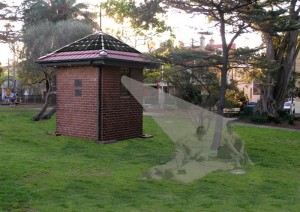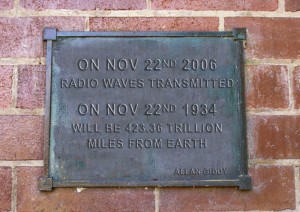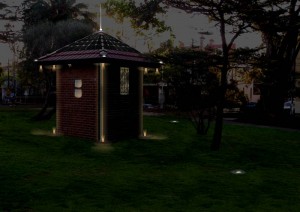proposed for City of Sydney’s ‘Glebe Point Road Public Art Project’, 2006
Site: The ‘Wireless House’ in Foley Park, Sydney.
Built in 1934, the ‘Wireless House’ was equipped with a crystal radio set audible through the apertures of the structure. Although a popular meeting place for Glebe residents and the unemployed, the service was terminated after a short time, after a government official declared that sitting around all day was not in the public interest and that the ‘Wireless House’ encouraged indolence.
Aim:
To reinvigorate the ‘Wireless House,’ transforming it from a redundant curio into an active element of the local community’s cultural milieu.
Method:
Through the innovative use of robust 21st century technology, the ‘Wireless House’ will be connected wirelessly to the internet. Located within the ‘House,’ a computer equipped with a wireless modem will receive streamed audio live from USA stations which play old-time radio (pre-1955) 24 hours a day. [1]
This streamed radio will then be projected to two specific, limited locations within the park via new technology. Ultrasound speakers mounted behind the windows inside the Wireless House will ‘shine’ sound onto precise areas of the surrounding grass without overspill into other areas of the park, or the surrounding streets. [2] The House will be subtly lit at night by a high-efficiency lighting system designed by the artist. The lighting element of this project will also include two 300mm (diam.) glowing discs, inset into the ground at the two points in the park where sound is audible. All energy used by the installation will be offset by a solar array designed for, and mounted on, the House’s roof.
[1] The broadcasts consist of music, news and public affairs
[2] See specifications for technical description

A new plaque will be attached to the building, to encourage viewers to consider the passing of time in relation to this quirkyold structure. It will read:

Concept:
I aim to reanimate this unique, quirky building, using cutting edge technology to respectfully reflect its history, giving a contemporary slant on its original purpose. A long-redundant public structure will be returned to public use and interest, and in doing so will bring the era of its construction to mind.
I envisage that the work will both attract an audience of passers by, and encourage picnicking locals to set up in the audio ‘spotlights.’
Thus the history of the building will be not only understood and respected but also furthered, whilst the needs and interests of local business and residents are also addressed.
